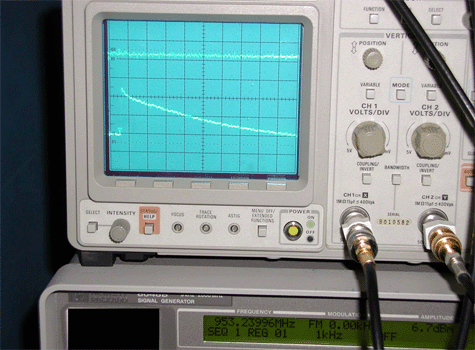|


Resonance-coupled photoconductive decay (RCPCD) display showing a real time measurement of minority-carrier lifetime. System operating frequency is 953 MHz.
Invited talk a the European Material Research Society in Strasburg, France, June 2002: “An advanced technique for measuring minority-carrier parameters and defect properties of semiconductors”. This was a description of the many uses of RCPCD: see Materials Science and Engineering B102, 161-172 (2003);
• Resonance Coupled Photoconductive Decay (RCPCD) measurements made on silicon spheres supplied by Texas Instruments (R. K. Ahrenkiel, D. Levi, and J. Arch, "Recombination Lifetime Studies of Silicon Spheres", Solar Energy Materials and Solar Cells 41, 171, 1996).
• First time-resolved photoluminescence (TRPL) experiments resulted in publication: R.K. Ahrenkiel, D.J. Dunlavy, R.Y. Loo and G.S.Kamath,"Minority Carrier Lifetime in n-Al0.38Ga0.62As",Journ. Appl. Phys.63, 5174(1988)).
• In 1986, Ahrenkiel obtained one of the first, large "work for others" contracts at SERI with Varian Corporation. During the course of that contract, Ahrenkiel invented the "zero field time-of-flight" (minority-carrier diffusivity. (M. L. Lovejoy, (INVITED PAPER), M. R. Melloch, R. K. Ahrenkiel and M. S. Lundstrom, "Measurement considerations for zero-field time-of-flight studies of minority-carrier diffusion in III-V semiconductors', Solid State Electronics 35, 251, 1992).
• In collaboration with Prof. Al Sievers of Cornell University, a new class of saturable absorbers were discovered based on adding the perhennate ion (ReO4-) to the KCl window material of CO2 lasers. This new material was also used to generate ultrashort picosecond pulses in CO2 lasers by insertion into the laser oscillator system (Optics Comm. 32, 503, 1980).
• Moving to the newly formed electronic photography effort, Ahrenkiel's group calculated the ultimate sensitivity of electronic photography (F. Moser, R. K. Ahrenkiel, and B. C. Burkey, "Photographic Speed of Solid-State Sensor Arrarys" , Photographic Science and Engineering 23, 261 (1979).
• Promoted to group leader at the Kodak Laboratories (~approximately 15 staff members) to develop new optical recording technology, Ahrenkiel and coworkers developed an optical recording scheme utliziing lasers to record binary information on magnetic insulators. Besides numerous technical publications, several articles were also published in the scientific popular press (Laser Focus, Feb 1975; Optical Spectra, Jan. 1975) describing this technology.
• Measured hole transport in the silver halides used in photography (Phys. Rev. 144, 576, 1966) for the first time. This work produced the first direct measurements of hole- mobility in AgBr.
• Developed contactless method to measure the Hall effects in polar phtoconducting insulators such as the alkali and silver halides. Measured the polaron mobility of lattice coupled-electrons in a number of ionic photoconductors (University of Illinois, 1964).
|